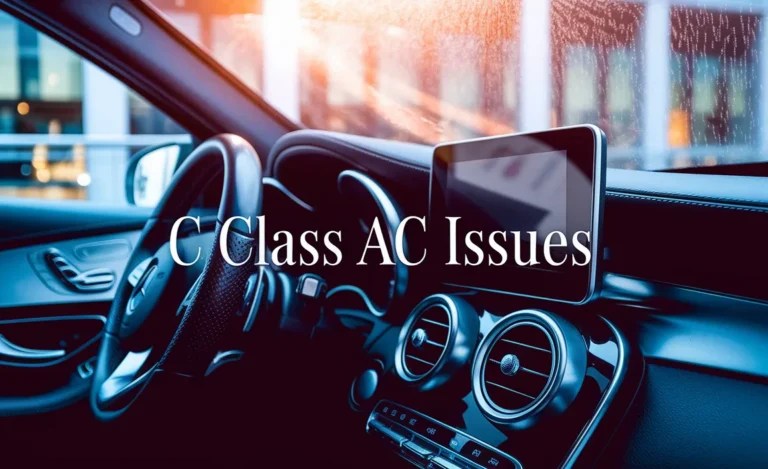Mercedes-Benz C Class Cabin Fuse: Ultimate Luxury Protection
The C-Class cabin fuse is a crucial, yet often overlooked, component that protects your vehicle’s delicate electronic systems. Understanding its location and function ensures you can quickly address electrical issues, maintaining the premium experience of your Mercedes-Benz C-Class and preventing costly repairs.
Driving a Mercedes-Benz C-Class is an experience in refined comfort and cutting-edge technology. From the climate control that perfectly adjusts to your preferences to the sophisticated infotainment system and ambient lighting that sets the mood, your C-Class cabin is a sanctuary. All these intricate features are powered and protected by a network of electrical circuits. At the heart of this protection lies the cabin fuse box, a vital component that safeguards your luxury against electrical surges and shorts.
While it might seem like a minor detail, knowing about your C-Class cabin fuse is key to preserving the seamless operation of your vehicle’s internal systems and avoiding frustrating electrical gremlins. This guide will demystify the cabin fuse, showing you exactly where to find it, what it does, and how to handle it confidently.

Understanding Your Mercedes-Benz C-Class Cabin Fuse: The Guardian of Luxury
In the world of luxury automobiles, every component plays a role in delivering an unparalleled driving experience. The cabin fuse in your Mercedes-Benz C-Class is no exception. Think of it as a tiny, but mighty, guardian for your car’s internal electronics. It’s designed to be the first line of defense, sacrificing itself to protect more expensive and critical electrical parts when an electrical fault or overload occurs.

Without it, a simple electrical surge could potentially damage anything from your navigation system to your power windows, leading to expensive repairs and a diminished sense of luxury.
What Exactly is a Cabin Fuse?
At its core, a fuse is a small safety device containing a metal wire designed to melt and break an electrical circuit. This happens when the current flowing through it exceeds a safe level. This intentional failure prevents damage to connected components and wiring.
In a Mercedes-Benz C-Class, the cabin fuse (or more accurately, the cabin fuse box containing many fuses) is responsible for protecting the various electrical circuits that power the interior features. These are distinct from the engine compartment fuses, which handle more robust powertrain and engine-related systems.
Why is Fuse Protection So Important in a Luxury Vehicle?
Mercedes-Benz vehicles are packed with advanced electronics designed to enhance comfort, safety, and entertainment. These systems are sophisticated and can be sensitive to electrical fluctuations. A properly functioning fuse system ensures that any anomaly is contained, preventing a cascade of failures.
This is especially true for a luxury vehicle like the C-Class, where even minor electrical malfunctions can detract from the premium experience. Imagine your climate control suddenly failing on a hot day, or your infotainment screen going dark. While inconvenient, the underlying issue might be a blown fuse that needs a simple replacement, rather than a complex and costly repair of the entire system.
Locating Your C-Class Cabin Fuse Box: A Step-by-Step Guide
Finding the cabin fuse box in your Mercedes-Benz C-Class is usually straightforward, though the exact location can vary slightly depending on the specific model year and trim. Mercedes-Benz engineers strategically place these boxes for accessibility, often within the cabin itself.
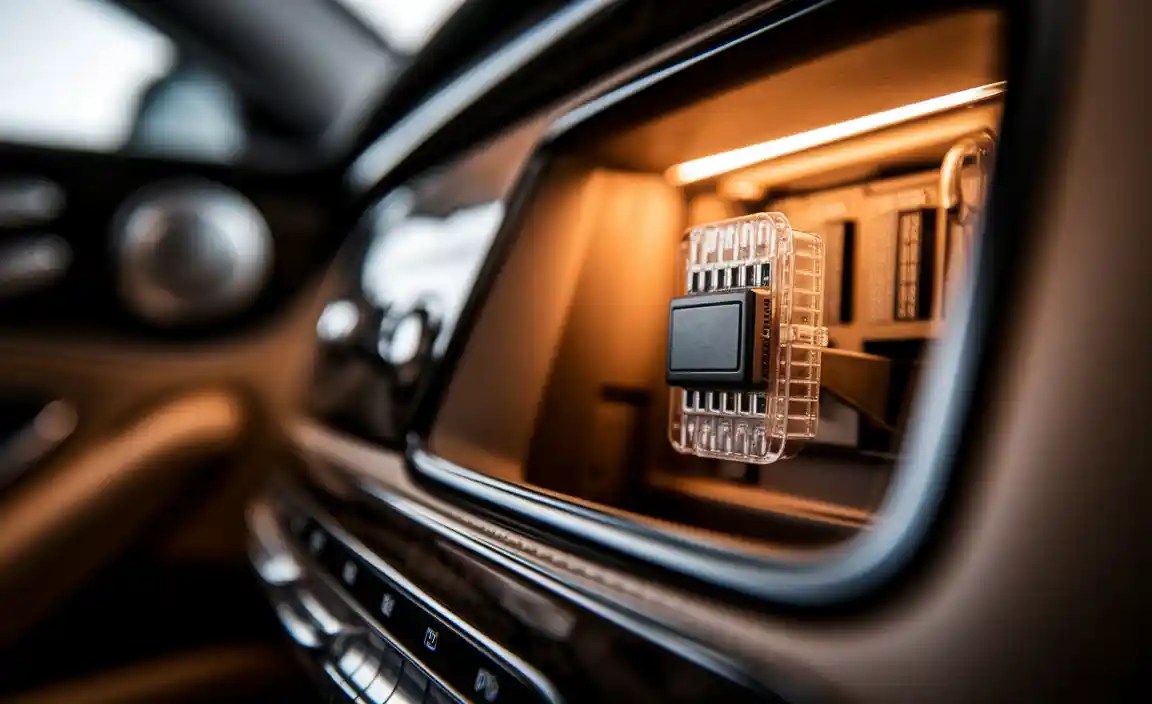
Common Locations for the C-Class Cabin Fuse Box
While always best to consult your owner’s manual for the definitive answer, here are the most common places you’ll find the cabin fuse box for most C-Class models:
Driver’s Side Dashboard: This is perhaps the most frequent location. It’s typically found on the side of the dashboard that faces the driver’s door. You might need to open the driver’s door to access it. Sometimes, there’s a small panel or cover that needs to be gently pried off or unclipped.
Under the Steering Wheel: Another common spot is on the underside of the dashboard, directly beneath the steering column. Look for a removable panel or a cover that can be pulled down or unlatched.
Passenger Side Footwell: Less common, but still possible, is a fuse box located on the side of the dashboard on the passenger side, often near the footwell. Again, a removable panel will likely conceal it.
Center Console: In some configurations, you might find a fuse box accessed through a panel within the center console, perhaps on the side or underneath.
How to Access the Fuse Box Cover
Once you’ve identified the general area, you’ll need to remove the cover. Most covers are designed for easy removal without tools.
1. Locate Fasteners: Look for small clips, indentations, or tabs around the edges of the panel.
2. Gentle Pressure: Apply gentle, even pressure to these areas. Some covers might require a slight pull downwards or sideways to release.
3. Avoid Force: If it feels stuck, double-check for hidden clips or a specific release mechanism. Forcing it can break the plastic.
4. Owner’s Manual is Key: If you’re unsure, your owner’s manual will have precise instructions and diagrams for your specific C-Class model.
Decoding Your C-Class Cabin Fuse Diagram and Fuse Types
Once the fuse box is exposed, you’ll see a multitude of fuses, each responsible for a different circuit. Understanding these is crucial for effective troubleshooting.
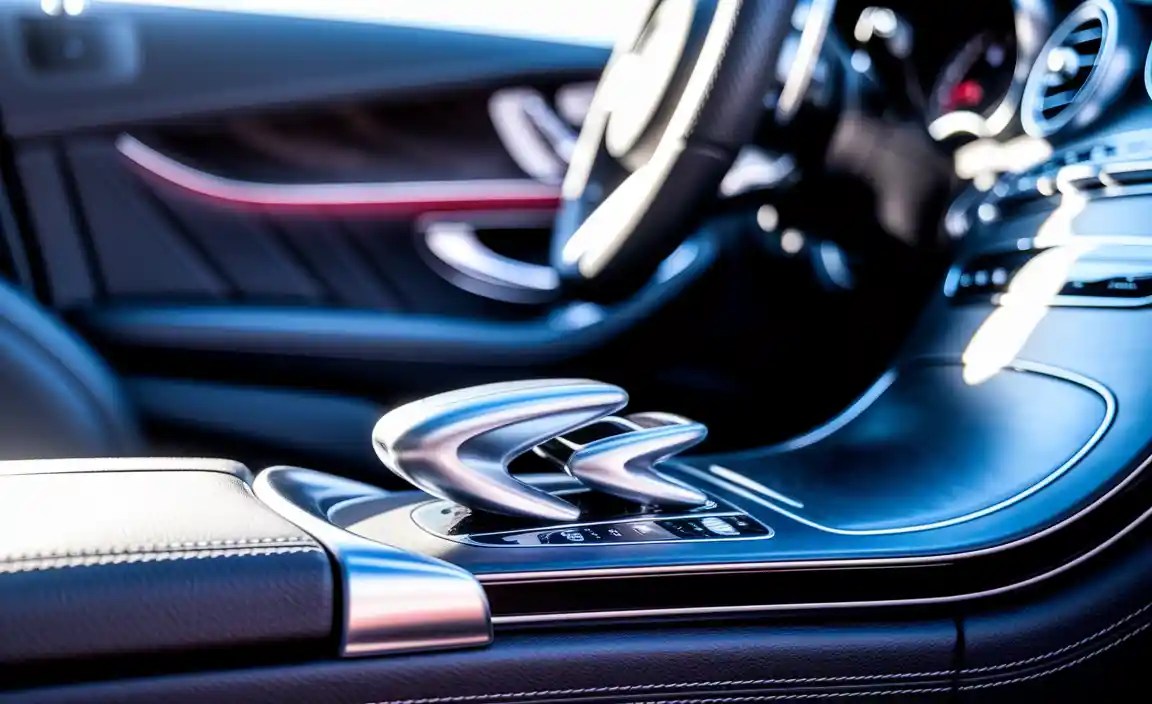
The Fuse Diagram: Your Blueprint
Every Mercedes-Benz C-Class fuse box comes with a diagram that identifies which fuse corresponds to which electrical function. This diagram can be:
On the back of the fuse box cover: This is the most convenient location.
Inside the owner’s manual: Often found in the section dedicated to technical specifications or maintenance.
Printed on a separate sticker: Sometimes affixed near the fuse box itself.
The diagram will typically display a grid of fuse slots, each labeled with a number or symbol. Next to it, you’ll find a description of the circuit it protects (e.g., “Interior Lighting,” “Radio,” “Power Seats,” “Sunroof”).
Understanding Fuse Amperage and Color Coding
Fuses come in various sizes and shapes, and more importantly, have different amperage ratings. The amperage (measured in amperes or “amps”) indicates how much electrical current the fuse can handle before it blows.
Color Coding: Automotive fuses are standardized by color to indicate their amperage rating. While there can be slight variations, the standard automotive fuse color code is widely used:
Standard Automotive Fuse Color Coding:
| Color | Amperage | Common Applications |
|---|---|---|
| Tan/Brown | 0.5A | Very low-power electronics, sensors |
| Violet | 1A | Low-power accessories |
| Gray | 2A | Instrument cluster lighting |
| Pink | 3A | Interior illumination, small relays |
| Red | 5A | Radio, cigarette lighter, small motors |
| Brown | 7.5A | Heated seats, minor accessories |
| Blue | 10A | Power windows, mirrors, basic lighting |
| Yellow | 15A | Wipers, cigarette lighter, moderate motors |
| Clear/White | 20A | Heated seats, power outlets, fan motors |
| Green | 25A | Power seats, sunroof, larger motors |
| Orange/Yellow | 30A | Rear defroster, fuel pump, heavier motors |
| Red | 40A | ABS pump, HVAC blower |
| Blue | 50A | Main power to accessories, larger systems |
| Green | 60A | High-power circuits |
| Gray | 80A | Very high-power circuits, often main fused links |
Amperage Rating: The amperage rating of a fuse is critical. It will be clearly marked on the fuse itself, usually by a number molded into the plastic housing and often color-coded according to the above chart.
Types of Fuses You’ll Encounter
Your C-Class will primarily use standard automotive blade fuses. These come in different sizes for different amp capacities:
Mini Blade Fuses: Smaller than standard, used in modern vehicles for compact electronic modules.
Standard Blade Fuses: The most common type, found in a wide range of vehicles.
Maxi Fuses: Larger, high-amperage fuses used for major circuits like the alternator or starter.
Cartridge Fuses: Less common in modern cabins but might be found in fuse boxes for older modules.
For the cabin fuse box, you’ll almost certainly be dealing with Mini or Standard Blade fuses.
How to Check and Replace a Blown Fuse in Your C-Class
When an electrical component in your C-Class cabin stops working, a blown fuse is often the culprit. Replacing one is a simple DIY task, but it requires care and attention to detail.
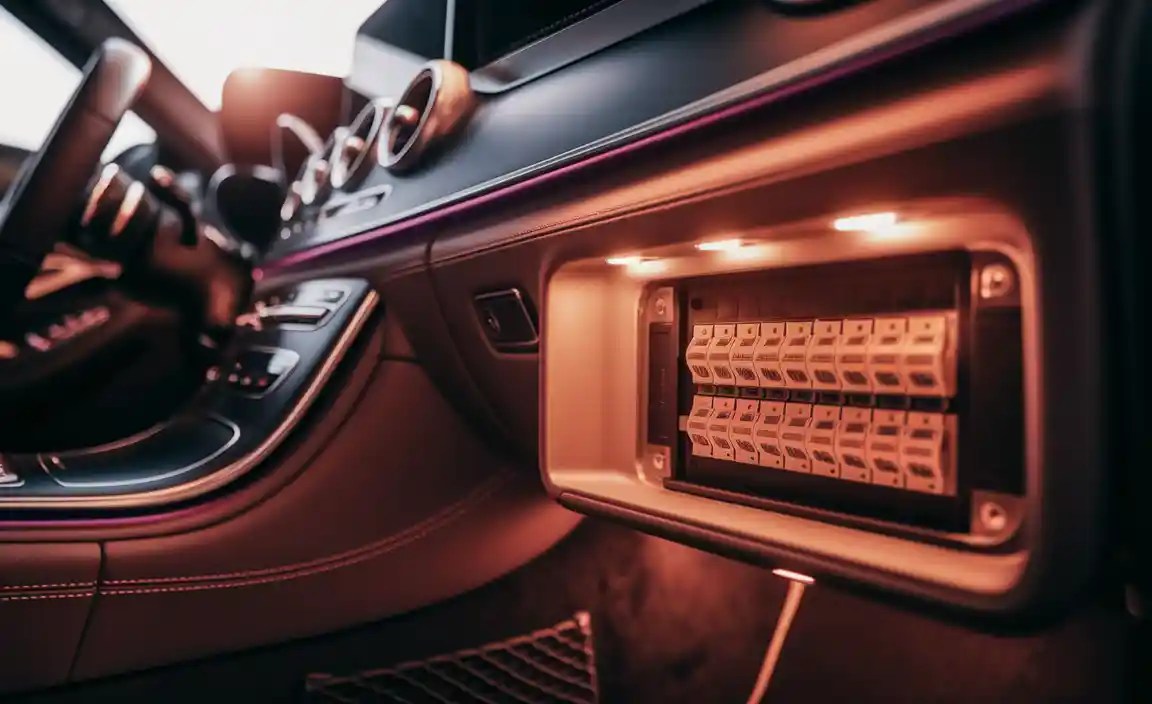
Tools You’ll Need
Fortunately, you won’t need an extensive toolkit for this job.
Owner’s Manual: Essential for locating the fuse box and identifying the correct fuse.
Fuse Puller: Most fuse boxes include a small plastic tool designed to grip and extract fuses. If yours is missing, needle-nose pliers can be used carefully.
Replacement Fuses: Ensure you have the correct amperage and type of replacement fuses. It’s wise to keep a small assortment of common fuses in your glove box.
Flashlight or Headlamp: To clearly see the fuse diagram and the fuses themselves.
Step-by-Step Fuse Replacement Process
1. Identify the Problem Circuit: Determine which electrical component is not working. For example, if your cigarette lighter (12V power outlet) isn’t functioning, that’s your starting point.
2. Consult the Fuse Diagram: Locate the fuse box and refer to the diagram to find the fuse responsible for that specific circuit. Note its position and amperage rating.
3. Turn Off the Ignition: This is crucial for safety. Always ensure the car’s ignition is switched off and the key is removed before working on fuses.
4. Locate and Extract the Fuse: Use the fuse puller (or needle-nose pliers) to grip the blown fuse by its plastic tab. Gently pull it straight out of its socket.
5. Inspect the Fuse: Examine the fuse. A blown fuse will have a visibly broken or melted metal filament inside its plastic casing. If the filament looks intact, the fuse may not be the issue, or there might be a deeper electrical problem.
6. Install the Correct Replacement Fuse: Select a new fuse with the exact same amperage rating and type as the one you removed. Never use a higher amperage fuse, as this can bypass the safety protection and cause severe damage or fire. Insert the new fuse firmly into the empty slot.
7. Test the Component: Turn the ignition back on and test the electrical component that was not working. If it now functions, you’ve successfully replaced the blown fuse!
8. Reassemble: Securely reattach any fuse box covers or panels you removed.
Important Safety Precautions
Match the Amperage: Never substitute a fuse with one of a higher amperage rating. This is paramount. Using a higher-rated fuse defeats its purpose and can lead to wiring damage, component failure, or even a fire. If you don’t have the correct replacement, it’s better to wait or seek professional help.
Use the Correct Fuse Type: Ensure you are using the appropriate type of fuse (e.g., Mini Blade, Standard Blade).
Check for Looseness: Make sure the replacement fuse is seated firmly in its socket. A loose fuse can cause intermittent issues.
Persistent Blowing: If a fuse blows repeatedly, it indicates a more significant electrical problem in that circuit. Do not keep replacing the fuse; have the system diagnosed by a qualified Mercedes-Benz technician.
Owner’s Manual Reliance: Always refer to your C-Class owner’s manual for the most accurate fuse locations and diagrams specific to your vehicle.
Common Electrical Issues and Their Fuse Box Connection
Several common electrical annoyances in a Mercedes-Benz C-Class can be traced back to a blown cabin fuse. Understanding these symptoms can help you quickly pinpoint the problem.
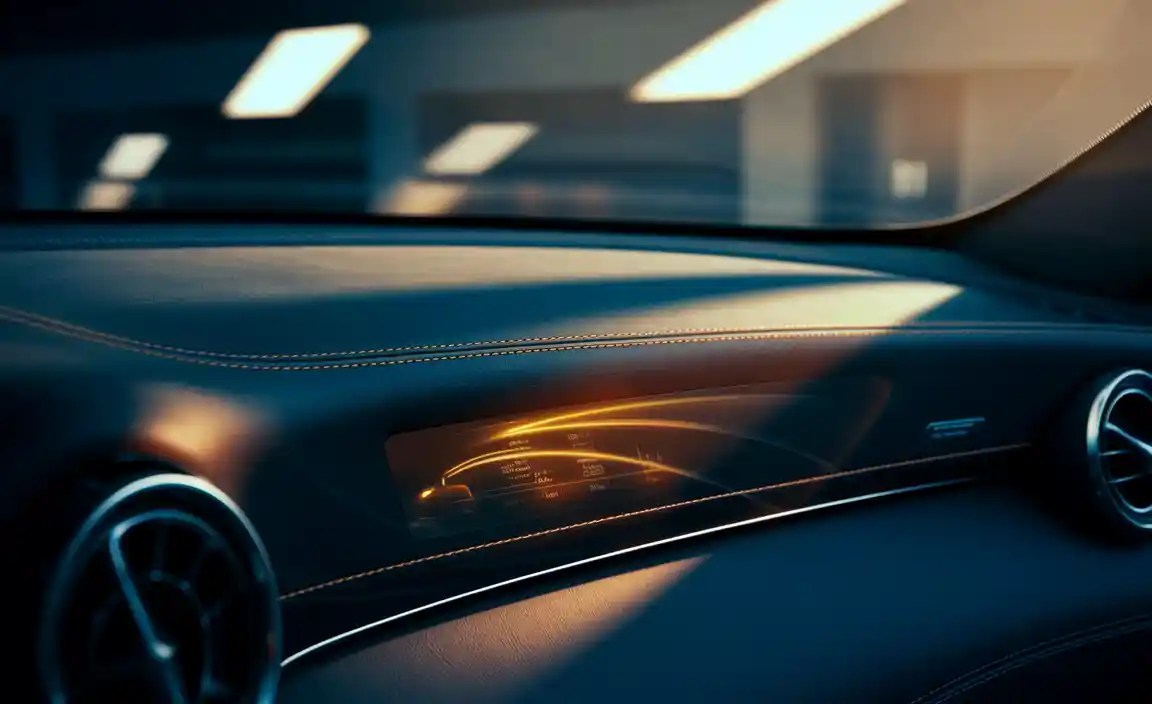
Symptoms Pointing to a Blown Fuse
Complete Failure of an Accessory: A power outlet (cigarette lighter), 12V socket, interior light, vanity mirror light, or seat adjustment suddenly stops working entirely.
Infotainment System Glitches: The radio, navigation, or display screen might intermittently or completely shut down.
Climate Control Errors: The blower motor might fail, or specific climate functions might cease to operate.
Power Seat/Window Malfunctions: If one or more power windows or seats stop responding.
Sunroof Not Operating: The power sunroof might refuse to open or close.
No Power to Specific Switches: Buttons or switches for accessories might become unresponsive.
Troubleshooting Flowchart for Electrical Issues
When an electrical component in your C-Class cabin fails, follow this logical approach:
1. Verify Component Failure: Is the component truly not working, or is it intermittent?
2. Check Owner’s Manual: Identify the fuse(s) associated with the faulty component.
3. Visually Inspect Fuse: Locate the fuse, turn off the ignition, and pull it out. Look for a broken filament.
4. Test with Known Good Fuse: If the fuse appears blown, replace it with a new one of the exact same amperage.
5. Test the Component: Turn the ignition on and see if the component works.
6. If it works: Great! You’ve fixed it. Keep an eye on it, but enjoy.
7. If it still doesn’t work:
Double-check that you used the correct fuse.
Inspect the fuse socket for any visible damage or corrosion.
Consider that the problem might not be the fuse, but the component itself or wiring issues downstream. In this case, professional diagnosis from a Mercedes-Benz expert is recommended.
8. If the new fuse blows immediately: This indicates a short circuit or a severe electrical fault. Do not continue replacing fuses; this requires immediate professional attention to prevent further damage.
When to Seek Professional Help
While fuse replacement is a straightforward DIY task, there are times when you absolutely should consult a qualified Mercedes-Benz technician:
Repeatedly Blown Fuses: As mentioned, this signals a deeper electrical problem.
Complex Electrical Systems: Issues with advanced features like ABS, ECU modules, or airbag systems should always be handled by professionals.
Uncertainty: If you’re unsure about any step, uncomfortable with the process, or can’t locate the correct fuse or diagram, it’s best to get expert advice.
Wiring Damage: If you suspect actual wiring damage, short circuits, or exposed wires.
Intermittent Problems: These can be notoriously difficult to diagnose and often require specialized tools and experience.
For more in-depth information on electrical system care and diagnostics, the National Highway Traffic Safety Administration (NHTSA) offers valuable consumer advice on vehicle maintenance and repair.
Maintaining the Luxury: Beyond Fuse Replacement
While managing your C-Class cabin fuses is important, maintaining the overall electrical health of your luxury vehicle involves a broader approach. Regular checks and proactive care can prevent many issues before they arise.
Preventative Measures for Your C-Class Electrical System
Regular Inspections: Periodically, when cleaning your car, take a quick look at the fuse box area. Ensure covers are in place and no obvious signs of damage are present.
Avoid Overloading Accessories: Be mindful of how many high-draw accessories you plug into your 12V outlets or USB ports simultaneously. While your C-Class is robust, excessive demand can strain circuits.
Use Quality Accessories: Always opt for reputable brands for charging cables, phone mounts, and other in-car accessories. Cheap, poorly made electronics can sometimes cause electrical problems.
Address Minor Issues Promptly: If a light flickers or an accessory acts sluggishly, investigate it. It could be an early warning sign that a fuse is starting to degrade or a connection is weakening.
* Professional Servicing: Ensure your C-Class receives scheduled maintenance at a reputable Mercedes-Benz service center. They can identify potential electrical issues during routine checks.
Understanding Different Fuse Box Locations (Summary Table)
To help you quickly reference, here’s a summary table of common fuse box locations:

| Vehicle Component | Likely Fuse Box Location | Likely Fuse Type |
|---|---|---|
| Interior Lights, Radio, Infotainment, Climate Control, Power Seats, Sunroof | Driver’s Side Dashboard (side panel) | Mini Blade, Standard Blade |
| Instrument Cluster, Steering Column Controls | Under the Steering Wheel (dashboard underside) | Mini Blade, Standard Blade |
| 12V |



